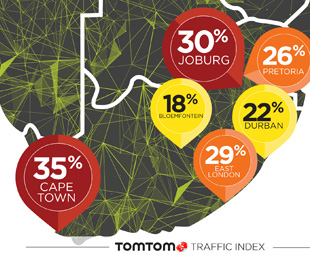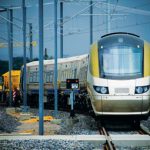Johannesburg scoops award for effective traffic management

TomTom has released the results of the TomTom Traffic Index (TTTI) 2017 – the annual report which provides details on the cities around the world with the most traffic congestion. In a study of 390 cities, Johannesburg – South Africa’s most densely populated city – stood out for its implementation of effective traffic-management systems across the city, earning special recognition from an international panel of traffic experts.
For the first time, this year TomTom is celebrating those cities that deserve special recognition for their efforts to beat traffic congestion with the introduction of the TomTom Traffic Index awards.
Using data from 2016, the TTTI looks at traffic congestion in 390 cities, in 48 countries, on six continents. TomTom works with nearly 19-trillion data points that have been accumulated over nine years.
While Johannesburg has long been considered South Africa’s most traffic-congested city, the TTTI shows a marked improvement in its ranking since 2009. Johannesburg has also surpassed Cape Town’s traffic congestion rating on the Index, ranking 70th globally with Cape Town positioned in 48th place.
Looking at TomTom’s historical data, traffic congestion is up by 23 percent globally since 2008 and up ten percent on 2015. The TTTI also provides useful comparative information between South Africa’s major metropolitan municipalities, with both Johannesburg and Pretoria indicating a decrease in traffic congestion between 2009 and 2012 and maintaining a relatively even traffic congestion rating in the following three years.
“Throughout South Africa, TomTom is empowering traffic authorities and key decision-makers at all levels of government with highly accurate historical and real-time insights into traffic flows and incidents,” explains Etienne Louw, MD at TomTom South Africa.
“Coupled with the real-time traffic information provided by TomTom’s navigation solutions, existing road infrastructure can be utilised with increased efficiency to counter rising traffic congestion,” he concludes.
Published by
Focus on Transport
focusmagsa




 !
From 1 Apri
!
From 1 Apri

 Big news from FOCUS on Transport + Logist
Big news from FOCUS on Transport + Logist





 FUSO: Driving the Future of Mobile Healthc
FUSO: Driving the Future of Mobile Healthc



 A brand
A brand




 Wondering about the maximum legal load for a
Wondering about the maximum legal load for a 
 The MAN hTGX powered by a hydrogen combus
The MAN hTGX powered by a hydrogen combus

 Exciting News for South African Operators
Exciting News for South African Operators
